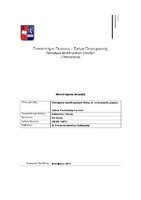Συστήματα προσδιορισμού θέσης σε εσωτερικούς χώρους
Indoor positioning systems

Master Thesis
Συγγραφέας
Πασιάς, Απόστολος Α.
Ημερομηνία
2015-12Επιβλέπων
Παναγιωτόπουλος, ΘεμιστοκλήςΠροβολή/
Λέξεις κλειδιά
Ασύρματα δίκτυα ; Ραδιοσήματα ; Εντοπισμός θέσης με δορυφόρους ; Global Positioning System ; Indoor Positioning System ; Satellite based positioning ; Global Navigation Satellite SystemsΠερίληψη
Από την αρχή της παρουσίας πάνω στη Γη, ο άνθρωπος ήθελε να γνωρίζει τη θέση του και τον προσανατολισμό του. Για το σκοπό αυτό χρησιμοποίησε μεθόδους που μπορούσε να κατανοήσει σε κάθε στάδιο της εξέλιξής του. Από την παρατήρηση των ορατών ουράνιων σωμάτων, σήμερα χρησιμοποιεί τους δορυφόρους και τη διάδοση ηλεκτρομαγνητικών κυμάτων.
Ο εντοπισμός θέσης γενικότερα (localization ή positioning) είναι η τεχνική του προσδιορισμού της θέσης ενός αντικειμένου ή ανθρώπου στο χώρο.
Η παρούσα διπλωματική εργασίας μελετά τις διάφορες τεχνικές και μεθόδους που εφαρμόζονται μέχρι σήμερα για τον εντοπισμό θέσης σε εσωτερικούς χώρους.
Το πρώτο κεφάλαιο αποτελεί την γνωριμία του αναγνώστη με το πρόβλημα του εντοπισμού θέσης γενικότερα.
Στο δεύτερο κεφάλαιο γίνεται ένας αρχικός προσδιορισμός του προβλήματος και των παραμέτρων του, καθώς και μια περιγραφή των στοιχείων που αποτελούν ένα σύστημα IPS (Indoor Positioning System).
Στο τρίτο κεφάλαιο, περιλαμβάνονται οι πιο συχνά χρησιμοποιούμενες κατηγοριοποιήσεις των συστημάτων IPS, με βάση διάφορα κριτήρια όπως την περιοχή εφαρμογής, τον τρόπο μέτρησης της απόστασης, την αρχιτεκτονική και την τεχνολογία που χρησιμοποιείται κ.λπ.
Στο τέταρτο κεφάλαιο, γίνεται μια εκτενής αναφορά στις μεθόδους και στις τεχνικές που χρησιμοποιούν τα σύστημα εντοπισμού θέσης σε εξωτερικούς και σε εσωτερικούς χώρους. Για τους εξωτερικούς χώρους γίνεται μια σύντομη αναφορά στα συστήματα GNSS (Global Navigation Satellite Systems), δίνοντας έμφαση στο GPS (Global Positioning System). Ειδικά για το GPS δίνεται μια γενική περιγραφή των υπολογισμών και των μεθόδων που χρησιμοποιεί. Στη συνέχεια, ακολουθεί μια εκτενής περιγραφή των μεθόδων και των τεχνικών που χρησιμοποιούνται στον υπολογισμό των αποστάσεων (TOA, TDOA, AOA, RSS, RTT) και τους αλγόριθμους υπολογισμού θέσης (triangulation, trilateration, Fingerprinting).
Στο πέμπτο κεφάλαιο, παρουσιάζονται οι τεχνολογίες ασύρματης επικοινωνίας που χρησιμοποιούν τα συστήματα IPS. Γίνεται αναφορά στις τεχνολογίες WLAN, WiFi, Bluetooth, Infrared, Ultrasound και RFID tags.
Στο έκτο κεφάλαιο, περιγράφονται τα ντετερμινιστικά και τα στοχαστικά μοντέλα διάδοσης ραδιοκυμάτων και παρουσιάζονται οι μηχανισμού διάδοσης τους (free space propagation, reflection, diffraction, scattering) καθώς και το φαινόμενο Multipath. Επίσης γίνεται μια πρώτη αναφορά στην επίδραση του κάθε μηχανισμού διάδοσης στα συστήματα IPS.
Στα κεφάλαια επτά και οκτώ επιχειρείται δίνονται απλά παραδείγματα εφαρμογών που στηρίζονται (local based) ή χρησιμοποιούν (location aware) την πληροφορία θέσης που παράγουν τα συστήματα IPS.
Στο κεφάλαιο εννέα, παρουσιάζονται ορισμένα συστήματα IPS (Active Bat, Cricket, Sonitor, κ.λπ.) που παρέχονται ως έτοιμες λύσεις και γίνεται μια συγκριτική αναφορά στα πλεονεκτήματα και στα μειονεκτήματά τους.
Η παρούσα εργασία κλείνει με το κεφάλαιο δέκα, όπου παρουσιάζονται τα συμπεράσματα πάνω στις μεθόδους και στις τεχνικές που χρησιμοποιούνται στον εντοπισμό θέσης σε εσωτερικούς χώρους, καθώς και τα περιθώρια εξέλιξης τους.


